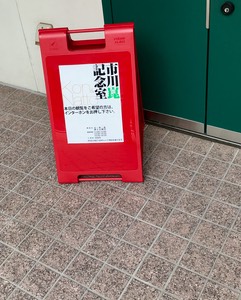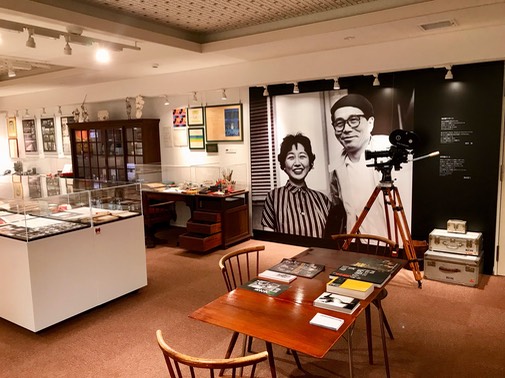
Having published on Ichikawa Kon before (see my article here), I’ve been meaning to do it for some time, but I finally made the trek to visit the Ichikawa Kon Memorial Room (市川崑記念室). It is a small museum in Shibuya dedicated to the illustrious filmmaker Ichikawa Kon and his scriptwriter wife, Wada Natto.
The museum itself is in Nanpeidaicho about a fifteen minute walk from Shibuya Station. It is located where Ichikawa and Wada had their house. The house was torn down and an apartment building built on the site in 2015. The first floor is where the Memorial Room is located.
It is not that large. The walls in the entrance hall are full of introductions to all of Ichikawa’s feature films. The main room is devoted to exhibits (see the photo below). On the walls are exhibits featuring some of his major films: Harp of Burma, Enjo, Her Brother, Ten Dark Women, Tokyo Olympiad, and The Makioka Sisters. They feature copies of the scripts, storyboards, press materials, and other items. Ichikawa was a very diligent and meticulous man, and he made colored charts for the productions of his films that are also on display. He was one of the first Japanese feature film directors to emerge from the world of animation, so his storyboards are quite delightful. Some of his last efforts at animation—cut out animation—are also on view, as are some materials from his TV work and a number of his awards. There are also his personal 35mm camera and Steenbeck editing table.
Some of the center display cases are devoted to Wada Natto, the brilliant scriptwriter who contributed so much to Ichikawa’s films and those of other filmmakers. You can see some of her original manuscripts—as well as her meticulously kept (as one would expect) household account book. Nearby is Ichikawa’s desk, which was very neatly maintained. (I wish they had a bit more of her work on display.) It seems that Ichikawa liked to work at the desk while Wada worked on the kitchen table or in the living room.
One thing you learn when looking at the desk is that Ichikawa was a big fan of Mickey Mouse. Not only are there many Mickey pens and character goods, but you see that Ichikawa’s favorite sandals featured Mickey (though, thankfully, not the ears).

Only a portion of Ichikawa’s and Wada’s materials are on display. Ichikawa kept materials from pretty much all his films, including scripts with notations and scrapbooks. The Memorial Room is not a library, but they can show materials that are not on display to researchers. Try contacting them via their website.
I had a great time. In my time slot, it was only me, so Wakabayashi-san of Kon Productions, who had worked as an assistant director on some of Ichikawa’s last films, showed me around. We talked a lot about the reception of Ichikawa at home and abroad.
You have to make a reservation by phone beforehand to visit the Memorial Room. In general, it is only open on Tuesdays, Wednesdays, and Fridays, in three time slots: 11-12, 1:30-2:30, and 3:30-4:30. Each slot can only accept a total of seven people. It costs 500 yen per person. You can only phone on the days they are open.
- Address: 18-4 Nanpeidaicho, Shibuya City, Tokyo 150-0036
- Phone: 03-3461-5541
- Website: http://www.konichikawa.com/memorial.html
Update: Check out my report on the Tora-san and Yamada Yoji Museum I visited the same day.

